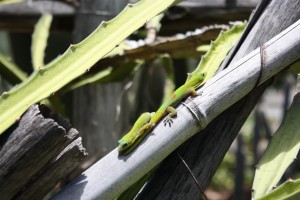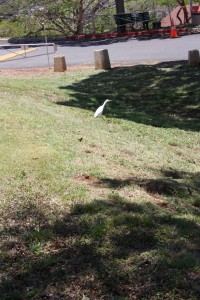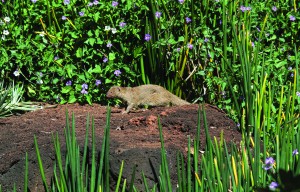This article is meant to accompany ‘Top 4: Rare, endangered, or threatened plants on campus‘.
From endemic plants that are found nowhere else on the planet, to the indigenous and naturalized varieties that have found a niche here in Hawai‘i, many threatened taxa are quickly finding their way onto the endangered red list of flora whose numbers are drastically low in the wild. Fortunately for us, some of these elusive varieties have found a home here on campus at KapCC.
However, our campus has also become a home to many of the invasive species that are in some part responsible for the decline of many native organisms to begin with.
4. Gold-dust day geckos
Phelsuma laticauda
On a clear day, these pied reptiles can be found sunning themselves in the cactus garden. According to the National Parks Service, it is believed that all of Hawai‘i’s terrestrial reptiles are non-native. Lizards do appear in Hawaiian mythology, and some of these species may have arrived with early Polynesians. In a paper from the U.S. Geological Survey, gold-dust day geckos, among others, are said to, “have a high risk of spread throughout the tropical Pacific,” with, “potentially devastating effects on native and endemic species.”
3. Cattle egrets
Bubulcus ibis
These lanky white birds tend to congregate around Mamane and the bus stops closest to Diamond Head. Sometimes their plumage is all white. Other times it displays traces of brown. They are one of many species foreign to the islands that have become a well-established part of Hawai‘i’s scenery. But the presence of the cattle egrets takes a toll on native wildlife. According to a post on the U.S. Fish and Wildlife Service (FWS) blog, both cattle egrets and barn owls prey upon Hawai‘i’s own endangered birds. The FWS has proposed a control order that would allow it, and other entities mentioned in the order to cull the number of these alien aves in specific places on Hawai‘i.
2. Mongooses
Herpestes javanicus
The plural of ‘mongoose’ is ‘mongooses.’ No geese here. The small Asian mongoose was first introduced to Hawai‘i as a biological control for rats in cane fields. That backfired because mongooses are active during the day, while rats are active during the night. Now, mongooses compete and prey upon “the eggs and hatchlings of birds and sea turtles, small mammals, reptiles, insects, fruits, and plants,” according to the Federal Highway Administration. They can also help spread leptospirosis. According to NOAA, both rats and mongooses, “are the principal vectors where transmission of the bacteria is made” via infected urine.
1. Feral cats

Toxoplasmosis gondii is a single-celled parasitic organism found in cats. Source: U.S. Department of Agriculture, Agricultural Research Service
Felis catus
During the day, a few feral cats can be found wandering around our cactus garden. As the day fades, they parade en force in the parking lots. On more than one occasion, people have been spotted leaving food out for the cats. These feline swarms are laying waste both directly and indirectly to Hawai‘i’s native fauna. Toxoplasmosa gondii is a single-celled parasite that is usually excreted in a cat’s feces. As of 2010, the parasite had killed four monk seals, according to NOAA. Keep in mind that only about 1100 of these seals are left in the wild. In April 2013, a study conducted by the University of Hawai‘i, the National Park Service, and the U.S. Geographical Survey provided the first video evidence of feral cats preying on endangered Hawaiian petrels.



